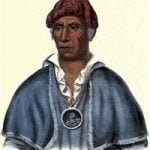
A Shawnoe Chief (Shawnee)
Quatawapea, or “The man on the water who sinks and rises again,” was born at the Pickaway Plains, in Ohio, almost sixty years ago, and was a boy at the great battle of the Kenhaw a, in which his tribe acted a conspicuous part. His father and all his ancestors were distinguished for their feats in arms. He was for many years the chief of that band of the Shawanoe tribe which resided at Lewistown, on the sources of the great Miami of the Ohio. With strangers he passed for a person of much consideration, in consequence of his fine address and appearance. He was a well formed, handsome man, dressed with much taste and elegance, and was graceful in his deportment. His horse and equipments, rifle, and side arms, were all of the most costly kind, and few of his race ever appeared so well on public occasions. As a hunter he had no superior; but he was not distinguished in council or in war.
During the late war between the United States and Great Britain, this chief joined the American army with a small band of his braves, and rendered himself extremely useful, on account of his intimate knowledge of the whole country which formed the seat of war on our north-western frontier. Only one martial exploit, however, is recorded to his honor. At a place called Savoirin’s Mills, he attacked a small fortification, at the head of his warriors, with such fury, that the British garrison was compelled to evacuate it hastily, and seek safety in flight. They were overtaken and many of them captured; the pursuit was continued for some hours; Vet it is a fact, highly honorable to this chief, and the Shawanoe warriors under his command, that not a scalp was taken, nor a prisoner put to death. The British soldiers who were captured were treated with the greatest humanity.
The reader will have observed, that it is not uncommon for the Indian warriors and chiefs to have several names, and that many-of them are named after eminent persons among their civilized neighbors. Thus the individual before us is better known by those who speak our language only, as Colonel Lewis, than by his original Indian designation.
He lived for many years near Waupaghconneta, in Ohio, where he cultivated a large farm, to which he devoted much attention. Unlike most of his race, he had learned the value of property, and exerted himself to increase his possessions. This conduct rendered him unpopular with his tribe, by whom he had never been greatly esteemed; and he was at length deposed by them, under a charge of peculation, in having applied to his own private purposes the money received from the United States for the use of his people.
It is said that his appointment to the station of chief was entirely accidental. Being one of a delegation which visited the seat of government while General Dearborn was Secretary of War, the superiority of Colonel Lewis, in dress and manners, probably induced the Secretary to regard him as the most conspicuous person of the party, and he presented him with a medal. On his return, the Indians regarding this decoration as an indication of the wishes of the American government, and desirous to testify their obedience to the hint which they supposed to have been thus given, yielded to him tacitly, a precedence which soon grew into a confirmed authority; and such is their rigid notion of discipline, and their habitual respect for their chiefs, that they submitted to him cheerfully while he remained in office. They even retained him for some time after they were satisfied of his unworthiness, at the instance of the agents of our government, who supported his cause, because they found him inclined to peace, and friendly to the whites.
After his deposition from the chieftainship, he emigrated with his family, and a few followers, to the country west of the Mississippi, allotted by the American government to the Shawanoes, where he died in 1826.
